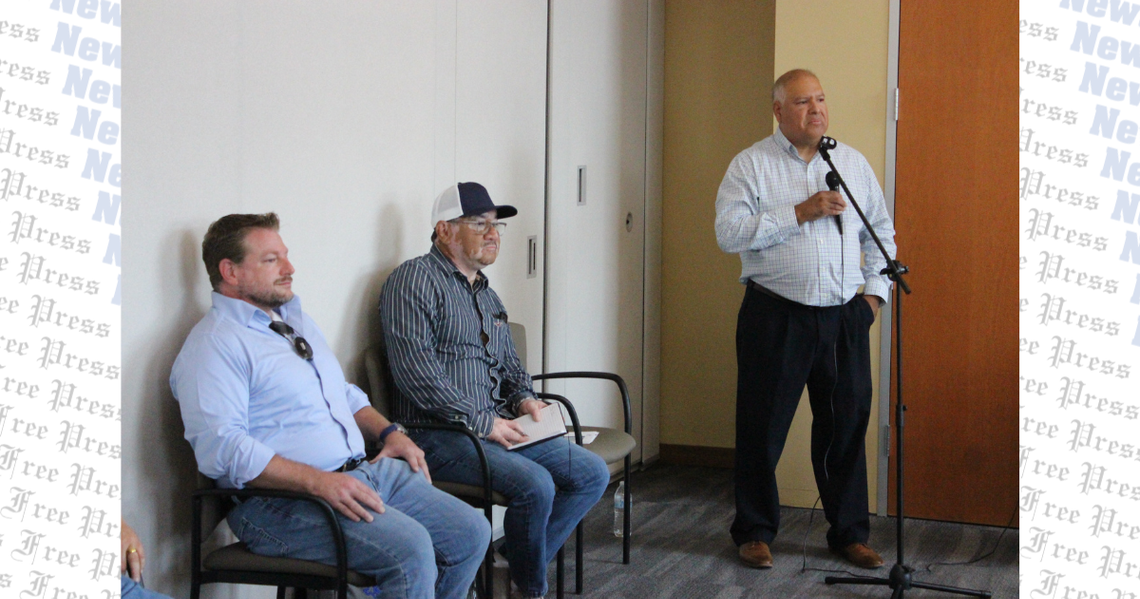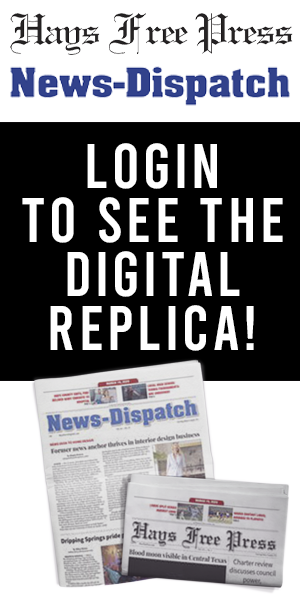KYLE — There was a full house Saturday, Aug. 2, as Kyle City Council member Michael Tobias took to Kyle City Hall to host a town hall with constituents.
Although many took to the floor to converse with Tobias on varying topics, a majority of those in attendance were concerned with the increase in water and wastewater rates, as well as the Kyle Sportsplex, both of which have been in recent discussion at council meetings.
Water, wastewater rates
As previously reported by the Hays Free Press, the recommendation for water rates inside for city limit customers is a 20% increase across the board, including commercial and multifamily homes, no matter the meter size.
For those outside the city, a 77% increase was recommended.
Regarding wastewater, the recommendation rates for those inside city limits was an increase of 6%, while 35% for those outside city limits.
Several residents of Six Creeks, a subdivision outside of the city limits, were in attendance and voiced their disappointment and outrage at the possibility of such a high increase.
“What I’m gathering here, when I’m having the conversations with the city managers, is … it’s to the point where we’re having such an influx of people that are coming in and the rationale was pretty much: We’ve got to be able to have a sense of balance as far as the city taxes that come in and also for those who are not within the city limits. So, the idea was that, as we’re developing, we need to be able to have more equality, as far as for the water,” said Tobias, who reaffirmed that the council has not voted on whether or not to approve the rate increases.
Council member Robert Rizo, who attended the meeting along with council member Marc McKinney — council member Miguel Zuniga was asked to leave to avoid calling a quorum — stated that the a rate study revealed that those within the city are subsidizing a lot of water for those outside the limits, making them pay for water they are not using: “So, we’re looking at finding out how we can change that,” he said.
In response, a resident stated that essentially, the city did not plan for its developments and the water needed for it. So, they questioned why the city would approve developments — and keep approving them — without the proper resources: “Where’s the responsibility here?”
“[I served] 37 years in the Army and so, it means that I’ve been all over the place and we’re settled here. Never in my life have I seen a place where you’re going to spend $120-$130 before you turn on the water. That’s insane,” said one Six Creeks resident.
Another explained that prior to moving to Kyle, he used to live in Austin, where a variable rate was used, which caused each homeowner to consider how much water they were using, since they were going to have to pay for it, and rewarded those attempting to conserve water.
“I just feel like we’re being discriminated against because we’re out of district and it’s just absolutely outrageous to think my water bill is going to go from $112 to $261 for water and wastewater. I’m one person on a fixed income. How do you do it if you have four kids and they’re living in a house … Who wants to live here and pay those kind of rates,” asked an attendee.
A conversation then began discussing possible solutions that the city could implement, such as mandatory hot water recirculation systems, which pulls hot water from a water heater, while sending cool water from the lines back to the water heater to be reused, according to Energy Star.
Additionally, someone mentioned greywater systems, which would take runoff water and recycle it into the system.
Taking accountability for the rapid increase in rates was Rizo, who stated that council “could have been raising the rate slowly … [but] the bill is due now and I think it’s going to be reflected on all of us. In city, out of city, everybody’s going to be paying for this now.”
“There’s got to be a way that the county can subsidize this to make it realistic for everyone, but having a $300 water bill, I’m just done … I’m retired. I don’t need this kind of crap in my life and I think other people will probably feel the same way. It becomes unaffordable,” said a resident.
Although not outside the city limits, other attendees also voiced their concerns with the increase, stating that “We’re looking at much less, [but] we’re also paying city taxes … So, we’re getting dinged, not with a 77% increase, but with everything else that’s within the city limits, including their property taxes, all of the 500-something fees in the city, [which] most of those are going up.”
Another solution mentioned was to bring more responsibility onto developers, by making them implement plans to conserve water for the city.
“So, gathering all this information, I can gather intel and then, I can go back to our city manager. I plan on having more meetings with our city officials to say, ‘Hey, look, this is what our residents are saying,’” said Tobias.
Kyle Sportsplex
Council recently approved a $161 million outdoor site masterplan for the upcoming Kyle Sportsplex at its July 15 meeting, which residents at the town hall stated could wait until the city is in a better position.
“If you are going to use the sportsplex for commercial purposes, you’re going to have to build an infrastructure for lodging. That’s probably going to take an additional seven or eight more motels that [the residents] are going to be on the hook for,” stressed an attendee. “We don’t have a public transportation system to take care of all these people coming from out of town … If things go south, we’re on the hook for [it]. We need to wait until this city has a larger tax base … where we have a tax base that is spread out over many people, so we don’t all bear the burden for the future of the city.”
Additionally, this same resident questioned how council can raise taxes when he can’t get answers to “how one of our council members is eating at Snooze every week, having coffees every morning.”
Echoing this sentiment was another, who emphasized that if there were “explanations for everything that the council does, maybe we wouldn’t need town hall meetings.”
According to Tobias, he only voted for the approval of the design because he was “curious about the rec[reation] center. I know there’s the big baseball fields and everything like that, but I really wanted to focus on that design process [for an indoor center] … because I remember a time when we didn’t have nothing.”
Those around the room then began brainstorming on how children could receive these same benefits from a sportsplex, without building the facility, including Tobias, who stated that, when he was younger, there was a summer where community members banded together to host a summer camp at one of the local schools.
This idea was further continued by a resident, who stated that her father created a program within his school district that would utilize the school gyms, teachers and more to provide gymnastic camps, swimming camps, cooking and sewing classes, etc. for children. This could not only provide relief for parents who are struggling to find daycare solutions in the summer, but also make use of the facilities that citizens of Kyle are already paying for.
“I appreciate you all for bringing up these difficult questions because we’ve got to ask those, but in the end, this is what it’s all about — talking to each other,” concluded Tobias. “This is not going to go away. One of these days, my term is going to end and we’ve got to continue that.”










